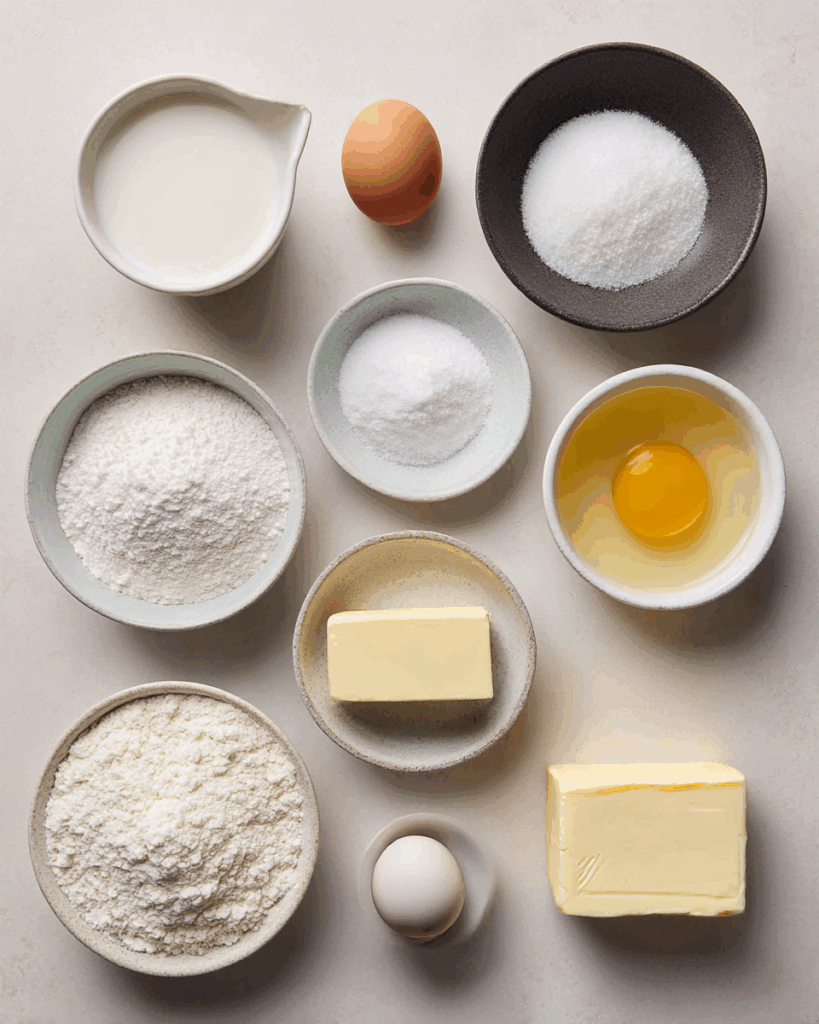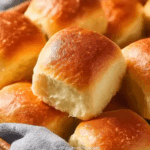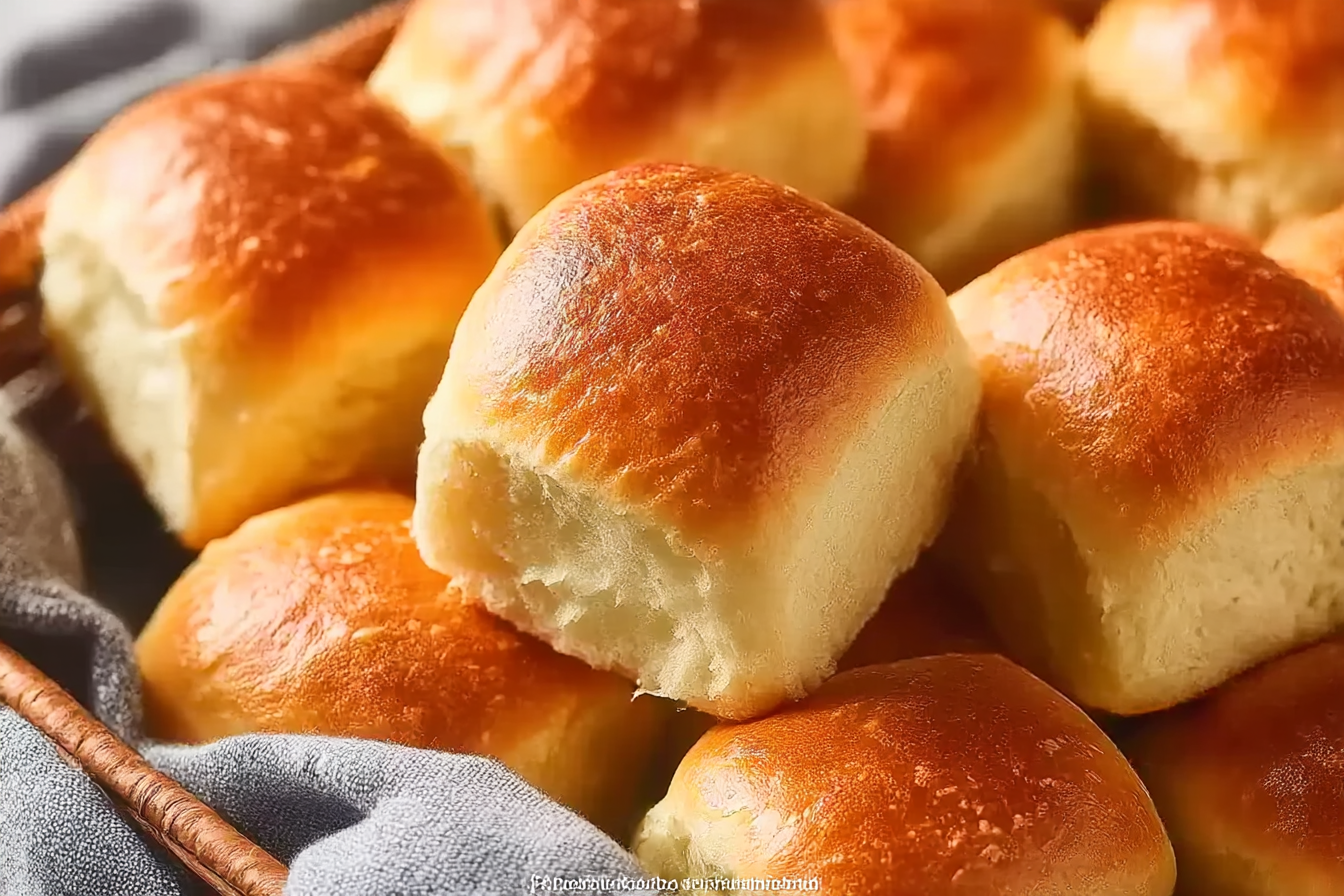Golden, buttery, and impossibly soft—Parker House Rolls are the kind of bread that disappears faster than you can say “pass the basket.” Their delicate crust gives way to a pillowy center, and that gentle fold through the middle makes them perfect for pulling apart and slathering with even more butter. These rolls don’t just grace the holiday table—they steal the show.
Behind the Recipe
The first time I made Parker House Rolls, I was chasing a memory—a warm, yeasty aroma wafting from the kitchen during a holiday dinner at my grandmother’s. The rolls would arrive at the table still steaming, brushed with melted butter and passed around like edible treasures. Recreating them became a mission, and with every batch, I got closer to that nostalgic softness, that golden sheen, that unmistakable sense of home.
Recipe Origin or Trivia
Parker House Rolls trace their buttery roots back to the Parker House Hotel in Boston in the 1870s. According to legend, a disgruntled cook slammed folded dough into an oven after an argument, accidentally creating the now-iconic crease. Their unique shape—folded like a letter—sets them apart, and they’ve since earned their place in American culinary history, from Thanksgiving feasts to everyday dinners.
Why You’ll Love Parker House Rolls
Trust me, you’re going to want to bake a double batch. Here’s why these rolls are so beloved:
Versatile: Perfect for dinner rolls, mini sandwiches, or even breakfast with jam.
Budget-Friendly: Made with basic ingredients found in almost every pantry.
Quick and Easy: Straightforward method with reliable results.
Customizable: Add herbs, garlic butter, or cheese for a flavor twist.
Crowd-Pleasing: Their softness and shine make them irresistible to all ages.
Make-Ahead Friendly: Dough can be prepped the day before and baked fresh.
Great for Leftovers: Reheat beautifully or transform into next-day sliders.
Chef’s Pro Tips for Perfect Results
Bread-making may seem intimidating, but with these tips, your rolls will turn out bakery-worthy every time:
- Use Warm, Not Hot, Milk: This helps activate the yeast without killing it.
- Let It Rise in a Warm Spot: Dough doubles best in a cozy environment—aim for about 75–80°F.
- Brush with Butter Twice: Once before baking for shine, and once after for flavor and softness.
- Fold Carefully: That classic crease shouldn’t be pressed too hard, just a gentle fold.
- Don’t Overbake: The rolls should be just golden on top—too long in the oven and they’ll dry out.
Kitchen Tools You’ll Need
You won’t need much, just your baking basics and a little love:
Mixing Bowls: For combining dough and letting it rise.
Stand Mixer with Dough Hook (Optional): Makes kneading easier, though hand-kneading works great.
Measuring Cups and Spoons: Accuracy is everything with baking.
Rolling Pin: To flatten the dough before shaping.
Baking Sheet: Large enough to hold the rolls with space to expand.
Pastry Brush: For those essential butter brushings.
Ingredients in Parker House Rolls
Each ingredient plays a part in achieving that soft, tender, and golden perfection. Here’s what you’ll need:
- All-Purpose Flour: 4 cups – Provides structure and a light crumb.
- Whole Milk (warm): 1 cup – Adds richness and moisture.
- Granulated Sugar: 1/4 cup – Feeds the yeast and adds slight sweetness.
- Active Dry Yeast: 2 1/4 teaspoons – Helps the dough rise to fluffy softness.
- Salt: 1 1/2 teaspoons – Enhances flavor and strengthens the dough.
- Unsalted Butter (melted): 1/2 cup – Infuses richness and creates a tender roll.
- Egg: 1 large – Adds structure and color to the dough.
- Butter (for brushing): 3 tablespoons – Gives that shiny, irresistible finish.
Ingredient Substitutions
Sometimes you have to work with what’s on hand. These swaps can help:
Whole Milk: Use 2% or even almond milk for a lighter version.
Granulated Sugar: Honey or maple syrup adds a richer sweetness.
Active Dry Yeast: Substitute instant yeast and skip the proofing step.
All-Purpose Flour: Bread flour can be used for a chewier texture.
Egg: Use 3 tablespoons of plain Greek yogurt as a binder if needed.
Ingredient Spotlight
All-Purpose Flour: Its lower protein content ensures the rolls stay soft and fluffy, not chewy or dense.
Butter: The star of the show, both in the dough and brushed on top, creating richness and that signature golden finish.

Instructions for Making Parker House Rolls
There’s something magical about watching dough rise and turn into something so delicious. Here’s how to make them:
-
Preheat Your Equipment:
Preheat oven to 350°F (175°C). Grease a large baking sheet or line with parchment paper. -
Combine Ingredients:
Warm the milk until just warm to the touch. In a large bowl, combine warm milk, sugar, and yeast. Let it sit for 5–10 minutes until foamy. Add melted butter, egg, and salt. Stir in flour gradually until a sticky dough forms. -
Prepare Your Cooking Vessel:
Knead the dough on a floured surface for 8–10 minutes until smooth and elastic, or knead using a mixer with a dough hook for 5–6 minutes. Place in a greased bowl, cover, and let rise in a warm place until doubled, about 1 hour. -
Assemble the Dish:
Punch down the dough and roll out to about 1/2 inch thick. Use a round cutter to cut circles. Fold each in half lightly and place seam side down on the baking sheet. Cover and let rise for another 30 minutes. -
Cook to Perfection:
Brush with melted butter and bake for 15–18 minutes, or until golden brown on top. -
Finishing Touches:
Brush immediately with more melted butter for a glossy, buttery finish. -
Serve and Enjoy:
Serve warm with a side of honey butter, jam, or as a dinner roll with your favorite meal.
Texture & Flavor Secrets
The perfect Parker House Roll should feel like a soft pillow—light, airy, and buttery with just a hint of sweetness. The exterior is lightly golden and tender, while the inside practically melts in your mouth. Folding the dough gives that classic layered bite with an irresistible pull-apart effect.
Cooking Tips & Tricks
Keep these pro tips in your apron pocket:
- Let dough rise longer if your kitchen is cool—don’t rush it.
- Brushing with butter after baking keeps the crust soft.
- Add a pinch of garlic powder or herbs for extra flavor.
What to Avoid
Avoid these common mistakes to ensure pillowy rolls every time:
- Hot milk: Can kill the yeast and prevent rising.
- Skipping the second rise: Results in dense, heavy rolls.
- Using too much flour: Leads to dry, tough dough.
Nutrition Facts
Servings: 16
Calories per serving: 160
Note: These are approximate values.
Preparation Time
Prep Time: 20 minutes
Cook Time: 18 minutes
Total Time: 1 hour 38 minutes (including rise time)
Make-Ahead and Storage Tips
You can absolutely prepare the dough the day before. After the first rise, cover tightly and refrigerate overnight. Let come to room temp and rise a second time before baking. Leftover rolls stay soft when stored in an airtight container at room temperature for up to 3 days. Reheat in the oven wrapped in foil or enjoy as-is. They also freeze beautifully—just thaw and warm before serving.
How to Serve Parker House Rolls
Serve these beauties warm with pats of salted butter, alongside a roast, or filled with sliced ham for mini sliders. They’re a classic on the holiday table but just as perfect for weeknight dinners or brunch spreads. Want something sweeter? Pair with jam and clotted cream for a decadent breakfast.
Creative Leftover Transformations
Don’t let a single roll go to waste! Here’s how to get creative:
- Mini Sandwiches: Fill with leftover turkey, ham, or chicken salad.
- Bread Pudding: Tear into chunks and bake with custard and cinnamon.
- Garlic Cheese Sliders: Add cheese and garlic butter, then toast.
Additional Tips
- Add a sprinkle of flaky salt on top before baking for a gourmet touch.
- Use a ruler or guide when cutting to ensure uniform rolls.
- For ultra-light rolls, give an extra 10 minutes for the second rise.
Make It a Showstopper
Presentation counts. Brush the tops generously with butter and line them up snugly for that bakery look. Sprinkle with sesame or poppy seeds for flair. Want extra shine? Use an egg wash for a golden hue before baking.
Variations to Try
- Herb Rolls: Mix chopped rosemary or thyme into the dough.
- Cheddar Parker Rolls: Add shredded cheddar for a cheesy twist.
- Garlic Butter Rolls: Brush with garlic-infused butter after baking.
- Sweet Parker Rolls: Add cinnamon sugar and drizzle with glaze.
- Whole Wheat Rolls: Swap half the flour for whole wheat to add nuttiness.
FAQ’s
Q1: Can I freeze the dough?
Yes, freeze after shaping. Thaw, rise, and bake when ready.
Q2: Can I make them gluten-free?
You can try with a gluten-free flour blend, but results may vary.
Q3: Why did my rolls turn out dense?
Likely under-proofed or over-floured. Let them rise fully and measure carefully.
Q4: Can I use a bread machine?
Yes, use the dough cycle, then shape and bake as directed.
Q5: Can I use instant yeast?
Yes, skip the proofing step and mix it directly with the flour.
Q6: How should I store leftovers?
In an airtight container at room temp for 3 days, or freeze for up to 1 month.
Q7: Can I use water instead of milk?
You can, but milk gives better flavor and softness.
Q8: Can I double the recipe?
Absolutely! Just use two baking sheets and rotate halfway.
Q9: How do I reheat them?
Wrap in foil and warm in the oven at 300°F for 10 minutes.
Q10: What makes them Parker House Rolls?
Their signature fold and buttery finish are what define them!
Conclusion
Soft, golden, and impossibly comforting—Parker House Rolls are the kind of bread you bake once and never forget. They’re not just side dishes, they’re conversation starters, passed from hand to hand with buttery fingerprints and happy sighs. Whether for a holiday feast or a casual weeknight dinner, these rolls belong on your table. And once you’ve made them, you’ll wonder how you ever lived without them.
Print
Parker House Rolls
Description
Classic Parker House Rolls are buttery, soft, and golden brown with a signature folded shape. Perfect for any dinner table, holiday feast, or cozy brunch.
Ingredients
- All-Purpose Flour: 4 cups – Provides structure and a light crumb.
- Whole Milk (warm): 1 cup – Adds moisture and activates the yeast.
- Granulated Sugar: 1/4 cup – Feeds the yeast and sweetens slightly.
- Active Dry Yeast: 2 1/4 teaspoons – Leavens the dough for softness and rise.
- Salt: 1 1/2 teaspoons – Enhances overall flavor.
- Unsalted Butter (melted): 1/2 cup – Adds rich flavor and tenderness.
- Egg: 1 large – Binds ingredients and enriches the dough.
- Butter (for brushing): 3 tablespoons – Brushed before and after baking for flavor and sheen.
Instructions
- Preheat Your Equipment: Preheat oven to 350°F (175°C). Grease or line a large baking sheet.
- Combine Ingredients: Mix warm milk, sugar, and yeast in a bowl. Let sit until foamy. Add melted butter, egg, and salt. Mix in flour gradually until a sticky dough forms.
- Prepare Your Cooking Vessel: Knead dough by hand or mixer until smooth. Transfer to a greased bowl, cover, and let rise 1 hour or until doubled.
- Assemble the Dish: Roll dough to 1/2 inch thick. Cut circles and fold each in half. Place seam-side down on baking sheet. Let rise 30 minutes.
- Cook to Perfection: Brush tops with melted butter. Bake for 15–18 minutes until golden brown.
- Finishing Touches: Brush again with melted butter right after baking.
- Serve and Enjoy: Serve warm with butter, jam, or use for sliders and sandwiches.
Notes
- Use warm—not hot—milk to activate yeast without killing it.
- Let dough rise fully to ensure fluffy rolls.
- Brush with garlic butter for a savory twist.

